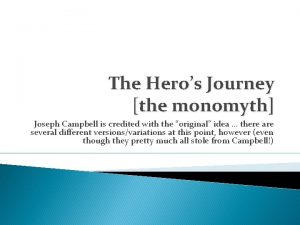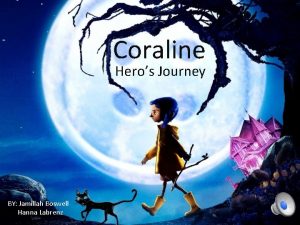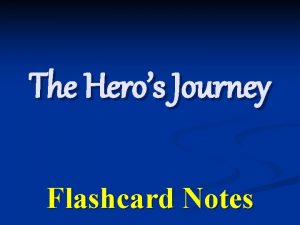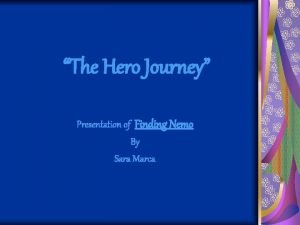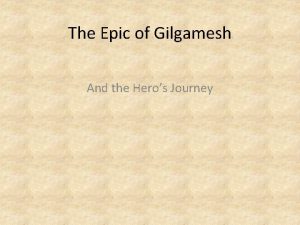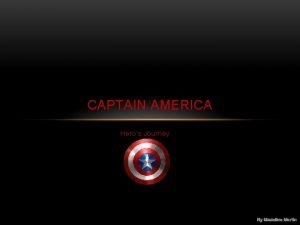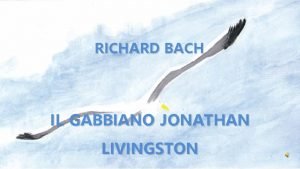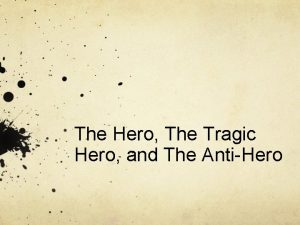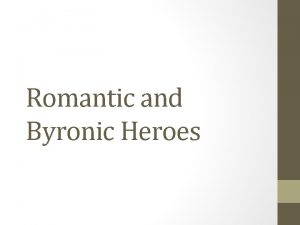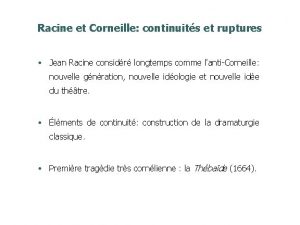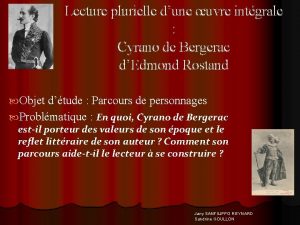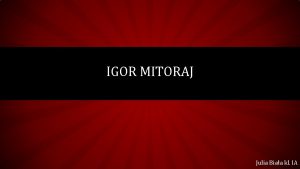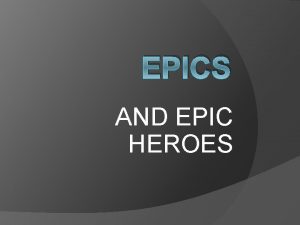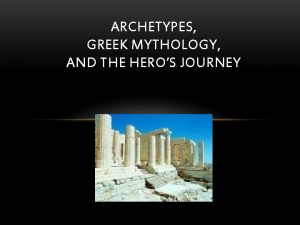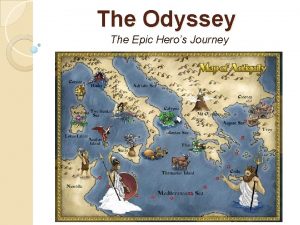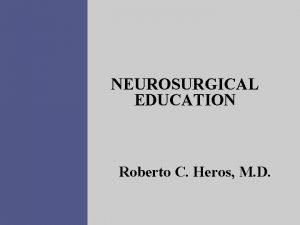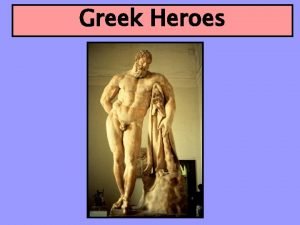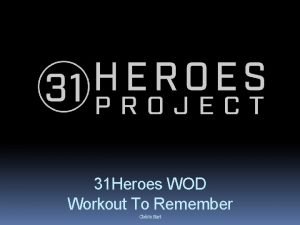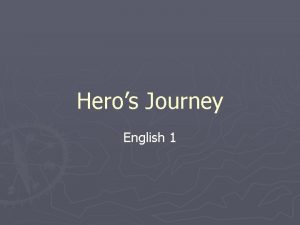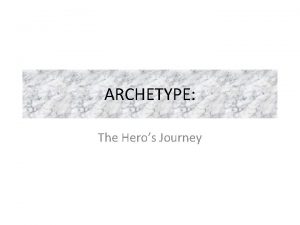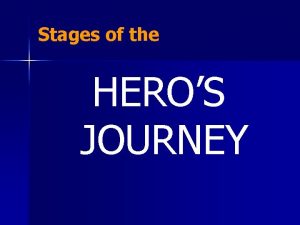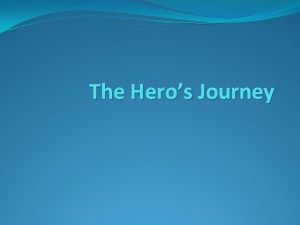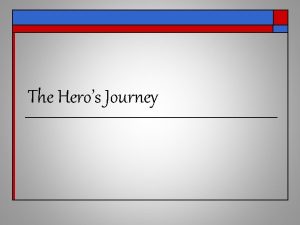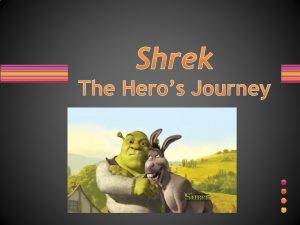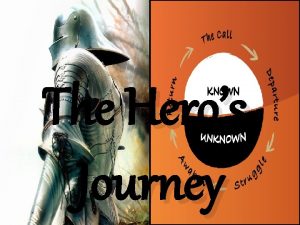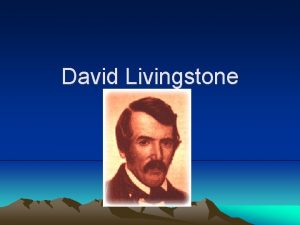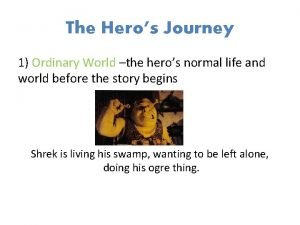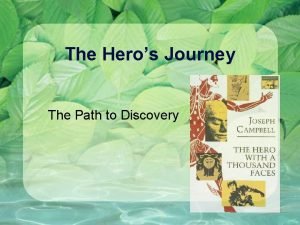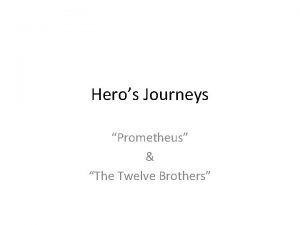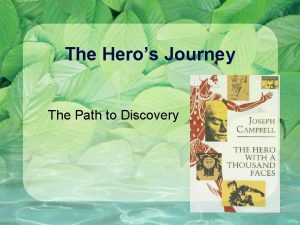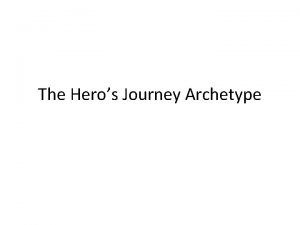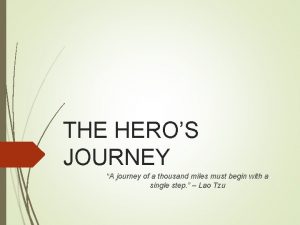The Heros Journey YEAR 10 ENGLISH LIVINGSTONE CHRISTIAN









































- Slides: 41

The Hero’s Journey YEAR 10 ENGLISH LIVINGSTONE CHRISTIAN COLLEGE

One explanation… Introduction The Hero’s Journey

The Hero’s Journey While watching the video, write down the role of each of these in The Hero’s Journey Hero Herald Mentor Threshold Guardians Trickster Shape-shifter Shadow

The Hero’s Journey A template/common storyline that most stories involving a hero will follow (and even some that don’t). Broadly involves: A hero going on an adventure, leaving his home Wins a decisive victory Returns home transformed/changed in some way Do you think The Hobbit fits this? Why/why not?

Joseph Campbell Writer who came up with the idea in The Hero with a Thousand Faces (1949) “A hero ventures forth from the world of common day into a region of supernatural wonder: fabulous forces are there encountered and a decisive victory is won: the hero comes back from this mysterious adventure with the power to bestow boons on his fellow man” In its full version, has 17 stages (you don’t need to know all of these).

The Hero’s Journey

The usual hero is someone: • *from whom something has been taken * who feels something is lacking from the normal experiences available or permitted to the members of his society "A hero is someone who has given his or her life to something bigger than oneself" -- Joseph Campbell

The HERO is introduced in the ORDINARY WORLD, where he receives THE CALL TO ADVENTURE The call to adventure is the point in the hero's life when he is first given notice that everything is going to change, whether he knows it or not. Before receiving this CALL TO ADVENTURE, the hero is typically leading a mundane existence in an ORDINARY WORLD. The Journey Begins…. I. The Departure /The Separation

NOTE: The HERALD does not necessarily have to be a person. It can be a force, such as a storm, or an animal such as an owl, etc. The HERALD can be anything that acts as a messenger to signal to the hero that a choice has to be made – that he is at the crossroads and he can heed the CALL TO ADVENTURE or ignore it. ALSO NOTE: The HERALD can function as other roles as well. Once he delivers the message, he can then become an ALLY or a SIDEKICK (for example). Such is the case with Dumbledore. He delivers the call to Harry and quickly becomes a MENTOR. The HERALD : Through a visit from the HERALD, the HERO receives the call. A HERALD is a character who serves as a harbinger, a messenger. Such a character delivers the HERO’s CALL TO ADVENTURE.

Some heroes set out responsibly and intentionally to perform the deed prescribed by the journey, as established in the CALL TO ADVENTURE. However, often when the call is given, the future HERO refuses to heed it. This refusal may be from a sense of duty or obligation, fear, insecurity, a sense of inadequacy, or any of a range of reasons that work to hold the person in his or her current circumstances. Eventually the HERO (in order to complete the journey) accepts the call, but it can take some time. REFUSAL OF THE CALL

ARCHETYPAL CHARACTERS Once the HERO has committed to the quest, consciously or unconsciously, his or her guide and magical helper appears, or becomes known. In addition to various helpers, the HERO may encounter other archetypal characters who help or hinder his journey. Archetypal characters are typical or stock characters, who tend to exhibit very similar characteristics all the time

Helper as ALLY By definition, an ALLY is someone on your side, someone there to help you achieve your goals. But in terms of the hero’s journey, an ALLY is of significant importance

Helper as ALLY Often, the ALLY may be a hero in his own right, having completed his own journey already. In many ways, ALLIES become greater heroes for partaking in this HERO's journey. The Ally is there to aid the HERO. Sometimes they have difficulty relinquishing their own ego/hero status. Other times they don’t grow at all. They simply help the hero.

ALLY as SIDEKICK Traditionally, the SIDEKICK is a character who is always there for the HERO and who the HERO can always count on. He doesn't experience growth or reap the benefits of the journey. The HERO would be crippled if he lost his SIDEKICK, but he would be able to complete his quest.

Helper as MENTOR The MENTOR is someone who has walked the HERO’s path before. MENTORS are typically in the shape of old men or women. Their role is to pass on advice to the HERO. Often the MENTOR will accompany the HERO on the quest, but this is not always the case. Sometimes MENTORS only appear in the HERO’s memory. MENTORS all pass on knowledge and learning to the new HERO and they may pass on boons (gifts) that will be useful along the quest as well. One common element that all MENTORS share is that at some point in the story they are going to have to step aside and let the HERO be a hero. This can be accomplished simply through the MENTOR being unavailable or the MENTOR may die.

More about MENTORS Uncle Ben dies early on, but still acts as Peter's/Spiderman's mentor Obi Wan Kenobi’s death is often viewed as the death of Luke’s MENTOR. It allows Luke to fulfill his role as HERO.

Helper as SUPERNATURAL AID is often presented as BOONS or TALISMANS - assistance given to the HERO by a supernatural source. The SUPERNATURAL AID HELPER is endowed with abilities beyond the normal. Wizards easily fall into this category, Gandalf and Merlin are perfect examples. The SUPERNATURAL AID will often provide the hero with a talisman or boon that will help him on his quest. Ben produces Luke's father's lightsaber. Merlin helps Arthur get Excalibur. Gandalf provides the party with Thror's Map which describes the secret entrance to the Lonely Mountain and Smaug's lair. Additionally, the One Ring, in The Hobbit absolutely falls into the category of SUPERNATURAL AID. Without it, Bilbo would not have succeeded.

Other Archetypal Figures Shapeshifter: The Shapeshifter's mask misleads the HERO by hiding a character's intentions and loyalties. Shadow: The Shadow can represent our darkest desires, our untapped resources, or even rejected qualities. It can also symbolize our greatest fears and phobias. Shadows may not be all bad, and may reveal admirable, even redeeming qualities. The HERO's enemies and villains often wear the Shadow mask. This physical force is determined to destroy the HERO and his cause. Trickster: Tricksters relish the disruption of the status quo, turning the Ordinary World into chaos with their quick turns of phrase and physical antics. Although they may not change during the course of their Journeys, their world and its inhabitants are transformed by their antics. The Trickster uses laughter [and ridicule] to make characters see the absurdity of the situation, and perhaps force a change.

This is the point where the HERO actually crosses into the field of adventure, leaving the known limits of his or her world and venturing into an unknown and dangerous realm where the rules and limits are not known. The THRESHOLD often manifests itself as a physical place, but it does not have to be. Sometimes the THRESHOLD is manifested as an actual barrier or boundary, such as a river, bridge, doorway, etc. The key that defines the CROSSING OF THE THRESHOLD is that it is where there is a clear definition that the HERO is no longer in the world of common day and is actually on the adventure itself. “We’re not in Kansas anymore. ” The Crossing of the Threshold

Thresholds Harry Potter crosses from the Ordinary World to the New World through Platform 9 ¾ at King's Cross Station. Lucy crosses into Narnia through the wardrobe.

THRESHOLD GUARDIANS When the HERO reaches the THRESHOLD, he will not be permitted to pass without effort. He must earn his passage across. To help him do that, and to turn less worthy individuals away from the path, are THRESHOLD GUARDIANS. To get further on in the adventure, the HERO must somehow overcome them. Sometimes the THRESHOLD GUARDIANS are very obvious because they are actually guarding a threshold. The THRESHOLD GUARDIAN is not necessarily evil, but, the THRESHOLD GUARDIAN’s role can be said to always be adversarial to that of the HERO. The job of the THRESHOLD GUARDIAN is to get the HERO to rethink whether or not he wishes to proceed on this adventure.

BELLY OF THE WHALE This is a biblical reference to the story of Jonah and the Whale. The BELLY OF THE WHALE represents the final separation from the hero's known world and self. It is sometimes described as the HERO’s lowest point, but it is actually the point when the HERO is between or transitioning between worlds and selves. The separation has been made, or is being made, or being fully recognized between the old world and old self and the potential for a new world/self. The experiences that will shape the new world and self will begin shortly, or may be beginning with this experience which is often symbolized by something dark, unknown and frightening. By entering this stage, the HERO shows his willingness to undergo a metamorphosis, to die to him or herself.

The Road of Trials The road of trials is a series of tests, tasks, or ordeals that the HERO must undergo to begin the transformation. The trials fall into two categories of hero deeds: The PHYSICAL DEED (the HERO performs a courageous act in battle or save lives) The SPIRITUAL DEED (the HERO learns to experience the supernormal range of human spiritual life and then comes back with a message). The Journey Continues…. II. Initiation

The Spiritual and The Physical

TESTS and TRIALS The trials the HERO faces are designed to see if he should really be a hero. Is he really a match for the task? Can he overcome the dangers? Does he have the courage, the knowledge, the capacity to enable him to serve? In addition, the HERO learns something about his own character through his adventures. There are several different challenges the HERO might face: Brother Battle: Many HEROES find themselves locked in battle, either physical or psychological with someone who is a "brother" whether a blood relation or a symbolic brother. Abduction / Sea Journey / Night Journey: Often in the HERO's journey, either the HERO or someone close to the HERO will be abducted and taken away. As the HERO is transported elsewhere, or as the HERO chases after the captors, the journey may take the HERO over the sea or on a long night journey. Even if there is no abduction involved, most HEROES are traveling great distances, so a sea journey or night journey is not uncommon. Dragon Battle: Some HEROES will battle literal dragons guarding their treasure, but other HEROES will battle their inner dragons, the doubts and fears they have about their own ability. Whether literal or figurative, the dragons must be slain in order for the HERO to complete the journey. NOTE: Often the HERO fails one or more of these tests. Often the tests occur in threes.

BATTLES Harry Potter's Underwater Battle Beowulf’s Dragon Battle

APPROACHING THE INMOST CAVE The Hero must make the preparations needed to approach the Inmost Cave that leads to the Journey's heart……………. . or THE SUPREME ORDEAL. Maps may be reviewed, attacks planned, possibly the enemy’s forces whittled down before the HERO can face his greatest fear, or the supreme danger lurking The Approach may be a time for some romance or a few jokes before the battle, or it may signal a ticking clock or a heightening of the stakes.

SUPREME ORDEAL The SUPREME ORDEAL is a test in which the HERO faces the central crisis of the story (not necessarily the climax) In an action movie, it will be the big action sequence. The key is that there is a central theme of death and change. The HERO will be submitted to death in some way or form.

SUPREME ORDEAL It could be the failure of his mission, the end of a relationship, the loss of his mentor, or facing his greatest fears. This is usually where the HERO will face the ENEMY for the first time in full form. Prior to this stage, the HERO has been battling minions and THRESHOLD GUARDIANS. The ENEMY was not truly out to stop the HERO. But now the worst the ENEMY has will be thrown the HERO’s way. Whatever the outcome, the HERO will emerge changed.

ATONEMENT WITH THE FATHER In this step the HERO must confront and be initiated by whatever holds the ultimate power in his or her life. In many myths and stories this is the father, or a father figure who has life and death power. This is the center point of the journey. All the previous steps have been moving in to this place; all that follow will move out from it. Although this step is most frequently symbolized by an encounter with a male entity, it does not have to be a male; just someone or thing with incredible power. For the transformation to take place, the HERO as he or she has been must be "killed" so that the new self can come into being. Sometime this killing is literal, and the earthly journey for that character is either over or moves into a different realm.

Symbolic Death or Dismemberment In order for the HERO to be transformed, he/she must give up his/her old life. Many times this is done through a symbolic death. In other stories, the HERO will lose a limb, which will signify the loss of the old self. As noted in the last slide, this event often occurs during the FATHER ATONEMENT, but not necessarily. SYMBOLIC DEATH OR DISMEMBERMENT

APOTHEOSIS or RESURRECTION When someone dies a physical death, or dies to the self to live in spirit, he or she moves beyond the pairs of opposites to a state of divine knowledge, love, compassion and bliss. This is a god-like state; the person is in heaven and beyond all strife. A more mundane way of looking at this step is that it is a period of rest, peace and fulfillment before the HERO begins the return.

RESURRECTION in detail The Hero faces the Resurrection, his most dangerous meeting with death. This final life-or-death Ordeal shows that the Hero has maintained and can apply all that he has brought back to the Ordinary World. This Ordeal and Resurrection can represent a "cleansing" or purification that must occur now that the Hero has emerged from the land of the dead. The Hero is reborn or transformed with the attributes of the Ordinary self in addition to the lessons and insights from the characters he has met along the road. The Resurrection may be a physical Ordeal, or final showdown between the Hero and the Shadow. This battle is for much more than the Hero's life. Other lives, or an entire world may be at stake and the Hero must now prove that he has achieved Heroic status and willingly accept his sacrifice for the benefit of the Ordinary World. Other Allies may come to the last minute rescue to lend assistance, but in the end the Hero must rise to the sacrifice at hand.

ULTIMATE BOON The ULTIMATE BOON or MAGIC ELIXIR is the achievement of the goal of the quest. It is what the person went on the journey to get. This step is also often called THE REWARD or THE SWORD. All the previous steps serve to prepare and purify the HERO for this step, since in many myths the BOON is something transcendent like the elixir of life itself, or a plant that supplies immortality, or the holy grail. Sometimes the HERO needs to engage in the THEFT OF THE ELIXIR and needs to return quickly after possessing it. If this is the case, he will be chased through his return and need to cross another threshold before re-entering the Ordinary World.

Refusal of the Return So why, when all has been achieved, the ambrosia has been drunk, and we have conversed with the gods, come back to normal life with all its cares and woes? Sometimes HEROES resist the return. Consider Harry Potter’s reluctance to return to the Dursley home and his stays with the Weasley family. Back to the Ordinary World… III. RETURN

Sometimes the HERO must escape with the boon, if it is something that the gods have been jealously guarding. It can be just as adventurous and dangerous returning from the journey as it was to go on it. Essentially, it is a movement away from the greater antagonism and manifests itself in a number of ways. It typically includes a flight with the treasure. Consider Andy Dufresne escaping with the Warden’s papers, the ones that prove the Warden to be corrupt. Magic Flight the chase with the ELIXIR

FINAL STEPS in the RETURN Rescue from Without Just as the HERO may need guides and assistants to set out on the quest, often times he or she must have powerful guides and rescuers to bring them back to everyday life, especially if the HERO has been wounded or weakened by the experience. Or perhaps the HERO doesn't realize that it is time to return, that he can return, or that others need his boon. The Crossing of the Return Threshold The trick in returning is to retain the wisdom gained on the quest, to integrate that wisdom into a human life, and then maybe figure out how to share the wisdom with the rest of the world. This is usually extremely difficult. Master of the Two Worlds In myth, this step is usually represented by a transcendental HERO like Jesus or Buddha. For a human hero, it may mean achieving a balance between the material and spiritual. The person has become comfortable and competent in both the inner and outer worlds. Freedom to Live Mastery leads to freedom from the fear of death, which in turn is the freedom to live. This is sometimes referred to as living in the moment, neither anticipating the future nor regretting the past.

There are many interpretations of the Hero’s Journey Cycle. It is depicted differently, with sometimes slight variations and sometimes entirely altered wording. Regardless, the pattern is what keeps people returning to Campbell’s work, reviewing our cultural stories, our origin tales, our religions, our films. It has also become a pattern for storytelling. This is quite obvious in the influx of Hero’s Journey films as of late. Take a look at some of the visual depictions of the cycle…. .



 Monomyth
Monomyth Mulan call to adventure
Mulan call to adventure Coraline sad
Coraline sad Heros journey notes
Heros journey notes Hero's journey finding nemo
Hero's journey finding nemo Gilgamesh journey
Gilgamesh journey Captain america heros journey
Captain america heros journey Mary moffat livingstone
Mary moffat livingstone Grade 8 livingstone high school uniform
Grade 8 livingstone high school uniform Il gabbiano jonathan livingston attività didattiche
Il gabbiano jonathan livingston attività didattiche Kejang demam simpleks dan kompleks
Kejang demam simpleks dan kompleks Epic hero vs tragic hero
Epic hero vs tragic hero Byronic hero romanticism
Byronic hero romanticism Héros racinien et cornélien
Héros racinien et cornélien En quoi cyrano de bergerac est un héros romantique
En quoi cyrano de bergerac est un héros romantique Heros de lumiere
Heros de lumiere Hero's theorem
Hero's theorem Heroes and celebrities
Heroes and celebrities Heroes in epics
Heroes in epics Archetype greek
Archetype greek Epic hero characteristics
Epic hero characteristics Roberto c. heros
Roberto c. heros Hero archetype traits
Hero archetype traits Nimfa opiekująca się zeusem
Nimfa opiekująca się zeusem Ideal heros
Ideal heros 31 heroes wod
31 heroes wod Heros de la mort aux trousses
Heros de la mort aux trousses Primary school leavers poems
Primary school leavers poems English learning journey
English learning journey Hình ảnh bộ gõ cơ thể búng tay
Hình ảnh bộ gõ cơ thể búng tay Lp html
Lp html Bổ thể
Bổ thể Tỉ lệ cơ thể trẻ em
Tỉ lệ cơ thể trẻ em Voi kéo gỗ như thế nào
Voi kéo gỗ như thế nào Chụp tư thế worms-breton
Chụp tư thế worms-breton Chúa yêu trần thế alleluia
Chúa yêu trần thế alleluia Môn thể thao bắt đầu bằng từ đua
Môn thể thao bắt đầu bằng từ đua Thế nào là hệ số cao nhất
Thế nào là hệ số cao nhất Các châu lục và đại dương trên thế giới
Các châu lục và đại dương trên thế giới Công thức tính độ biến thiên đông lượng
Công thức tính độ biến thiên đông lượng Trời xanh đây là của chúng ta thể thơ
Trời xanh đây là của chúng ta thể thơ Cách giải mật thư tọa độ
Cách giải mật thư tọa độ
